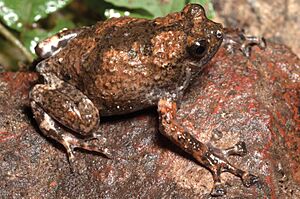Kalinga narrowmouth toad facts for kids
Quick facts for kids Kalinga narrowmouth toad |
|
|---|---|
 |
|
| Conservation status | |
| Scientific classification |
The Kalinga narrowmouth toad (Kaloula kalingensis) is a special kind of frog. It belongs to a family of frogs called Microhylidae. This toad is found only in the Philippines, which means it is endemic there. It lives in warm, wet places like forests, farms, and plantations. Sadly, its home is shrinking, which puts it at risk.
What Does It Look Like?
The Kalinga narrowmouth toad is a plump frog. It has a rounded body and a short head. Its snout is short and flat at the end. The nostrils are on the side of its head. You can easily see its eardrums (tympani).
This toad has small bumps, called tubercles, on its snout, face, back, and sides. The skin on its belly is bumpy, but its chest is smooth. Its fingers have white bumps underneath. They also have small pads at the tips. Its toes are slightly webbed, like tiny paddles.
This frog is about 36 millimetres (1.4 in) long from its snout to its rear end. Its back is bluish-black. It has reddish-brown marks on its head, sides, and legs. Its belly is brown with white spots.
Where Does It Live and What's Its Home Like?
This unique frog lives only in the Philippines. It is found in the Cordillera Central Mountains on the island of Luzon. It might also live in the Sierra Madres Mountains. You can also find it on Polillo Island and Palaui Island.
The Kalinga narrowmouth toad lives in rainforests. These can be in lowlands or on lower mountains. It usually stays on the forest floor. It also likes to hide in rain-filled holes in trees. It uses other temporary water spots too.
During the breeding season, male toads call out. They call from holes in trees or from under logs. Their call is a loud, slightly wavy trill. People have described it as "Bwop!"
Scientists have found other similar frogs. These might be new species of Kaloula toads. They have been found in Panay (Sibalom Natural Park) and eastern Luzon.
Why Is It Important to Protect It?
The Kalinga narrowmouth toad's total living area is quite small. It is less than 20,000 square kilometres (7,700 sq mi). Within this area, the groups of toads are spread out. The biggest danger to this toad is that its forest home is being destroyed. We don't know for sure if the total number of these toads is going down.


